Zhu Di - the Yongle Emperor
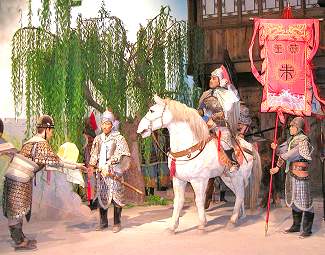
Jingshi (Nanjing) capitulates to Zhu Di
A Bitter Civil War

The 3rd Ming emperor with reign title of Yongle ("Perpetual Happiness") was the 4th son of the 1st Ming emperor, Zhu Yuanzhang.
Born as Zhu Di on 2 May 1360, he was Prince of Yan and commander of China's northern frontier army around today's Beijing, when his father died in 1398.
When his father passed away, Zhu Di was the oldest surviving son of the Ming dynasty founder and he harbored a strong opinion that he be the natural successor to carry the Mantle of Heaven.
But Zhu Yuanzhang had instead chosen as his successor his grandson Zhu Yuwen, 2nd son of Zhu Yuanzhang's eldest son. The choice followed the rule of primogeniture, by which the eldest son (who had already passed away) or the first grandson of the eldest son should succeed the emperor.
Zhu Yuwen with reign title of Jianwen soon embarked upon the elimination of his uncles, but was no match for Zhu Di. After four years of bitter civil war Zhu Di conquered Nanjing, the Jianwen Emperor disappeared and Zhu Di installed himself as the 2nd emperor of China's Ming Dynasty in 1402 with reign title of Yongle.

Zheng He's main vessel
Zhu Yunwen's reign was formally reinstated in 1599 and Zhu Di's reign accordingly got its proper designation as the 3rd Ming emperor with reign title of Yongle.
Expansion and Prosperity
The Yongle Emperor was a strong leader and a natural ruler. He reinstated a solid government system and appointed able ministers. His 22 years of rule till his death in August 1424, 64 years old, was both expansionist and prosperous.
Militarily, he eliminated the last pockets of Mongolian resistance in the south, led five major campaigns against the Mongols in the north and with diplomatic skill suppressed the Jürchen, Koreans and Japanese. His envoys reached Java, Central Asia and even the Middle East.
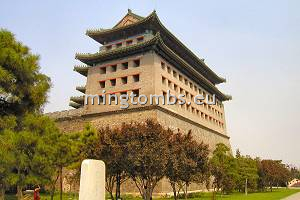
The Ming SE Corner Tower
He dispatched the great eunuch admiral Zheng He on seven famous maritime expeditions reaching as far as the Persian Gulf, the Red Sea and the East African coast, visiting a total of 30 nations between 1405 and 1433. He justified the huge expense by claiming that the fleet was to find and kill the escaped Jianwen emperor.
On 12 August 1424, the Yongle Emperor died while on a military campaign against the Tartars in the Gobi desert.
Beijing Becomes Capital again
From his years as commander of the northern army territories the Yongle emperor knew all too well the danger of another invasion by the Mongols. He therefore in the early 15th century made the monumental decision of moving the imperial capital from Nanjing to Beijing.

Zhu Di assesses designs for his Forbidden City
Construction of the new capital was decided in 1406 and got under way in 1407. It was completed 13 years later in 1420 with the official inauguration held in February 1421.
As to exact location, Zhu Di decided to use the original site of the earlier Yuan dynasty (1279-1368), which was a couple of kilometers north of the previous capital sites in Beijing.
At its height, more than 200,000 workers were deployed in the construction. The West Palace and outer city walls were completed in May 1417 at which time Yongle moved his court to the new capital. His main palace is extremely well known even today as "The Forbidden City" -or Gu Gong in Chinese.
The outer walls were finally reinforced with large brick in the late 1420's -after the Yongle Emperor's death. The walls stood for over 500 years until they were removed in the 1950's to make room for traffic and a subway. Today very little remains of these walls. Best preserved are Qianmen tower at the southern end of Tiananmen Square and the SE Corner Tower. The latter now lines Beijing's 3rd Ring Road and caresses the start of the famous Tonghui Canal.

Changling layout
The Yongle emperor's mausoleum occupies the largest area of all Ming tombs in the Tianshou mountains north of Beijing.
It is equipped with a double entry gate and most of the typical buildings used in Ming and Qing tombs.
More importantly for us today, the constructions are all in a well preserved state -particularly the huge, main ceremonial hall with its precious Nanmu wood columns.
Tomb location:
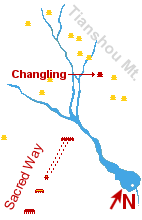
Google Earth:

A Tomb for An Empress -

Changling in front of Mt. Tianshou
Having moved his capital north from Nanjing to Beijing, the Yongle Emperor consistently also changed the location of the Ming imperial mausoleum to Beijing from Nanjing, where his own father, the first Ming emperor, was interred
More pressing things were on his mind, but when Empress Xu died in 1407, the Yongle Emperor directed his attention to finding a perfect geomantic location for the future imperial mausoleums. Mount Tianshou in Changping county some 50 km northwest of Beijing proved an excellent choice, with the clean water of Wenyu River in front of a flat, fertile plateau surrounded and protected by mountains on all sides.
Construction of the underground tomb for Empress Xu started in 1407 and was completed four years later. It is named Changling (长岭 or "Tomb of Longevity").
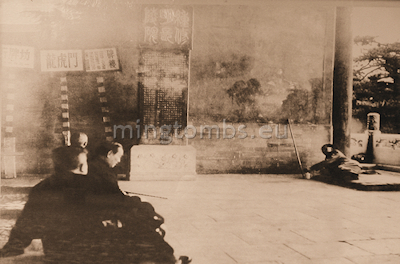
Mao Zedong at Ling'enmen in 1954
- and for An Emperor
Zhu Di, with reign title of Yongle, was also buried in Changling when he passed away in 1424. The tomb has not been re-opened or excavated since he was entombed and has presumably not been robbed.
The common Sacred Way for all Ming tombs at Mt. Tianshou naturally leads directly to Zhu Di's own tomb since he founded the entire mausoleum area.
The layout above ground follows his father's mausoleum (Xiaoling) in Nanjing. South to north, the structures along the main axis are the front gate, Ling'en Gate, Ling'en Hall, the gate to the burial area, Lingxing gate, the five ceremonial vessels, the "Square City" with the memorial tower (Minglou) on top, and finally the earth mound ("Precious Mound").
The underground chambers were completed by 1411 but the above-ground structures were only finalized in 1418, seven years later.
- not to Mention some Concubines
Not only the Emperor and the Empress were buried in Changling. In line with custom in those days, sixteen (some say 30) consorts were required to commit suicide. After an honorary feast, they were made to stand on a wooden bed with ropes around their necks after which the bed was pulled away. They were all interred in the tomb.
Main Tomb Entrance and Stele Pavilion
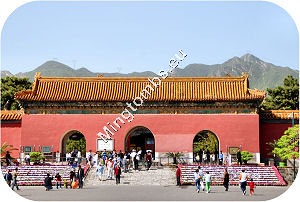
Changling front gate
Only three of the mausoleums around Mt.Tianshou have an extra front gate to the tomb site, Yongling, Dingling and Changling. This front gate has three openings and is covered by a single eaved roof with yellow glazed tiles (see photo). The center gate -for the exclusive use of the Emperor and the Empress- is taller than its sisters on each side.
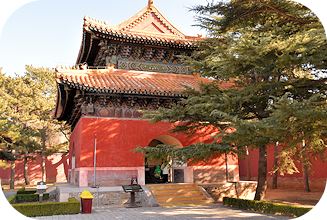
Changling Stele Pavilion
Just inside the tomb walls and east of the front gate is a unique stele pavilion, a square structure with a double eaved gable roof covered with yellow glazed tiles. Inside the pavilion is a stele erected on a base shaped like a Chinese stone dragon -and not the traditional tortoise.
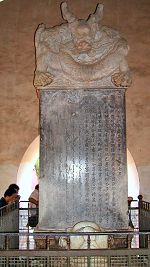
Stele with
inscriptions
There is no solid evidence of exactly when this stele was erected. Some sources claim that it was erected without inscriptions by the Ming in 1542 -more than 100 years after the death of the Yongle Emperor. There is, at least, written evidence dating back to the 1650's - during the subsequent Qing dynasty - that the stele and its pavilion existed then and that the stele carried no inscriptions at that time.
The current imperial edicts engraved in both Chinese and Manchu on three sides were added by the later Qing emperors reigning as Shun Zhi (1659), Qian Long (1786) and Jia Qing (1804).

Plague
This stele and its pavilion has no counterpart in any other Ming tomb in Shisanling. This fact and the uncertainty of when it was erected, lead to the speculation that it was a practical construction added by the subsequent Qing dynasty and mainly served the purpose of a vehicle carrying records of tomb repairs etc.
Ling'en Men - Gate of Eminent Favor
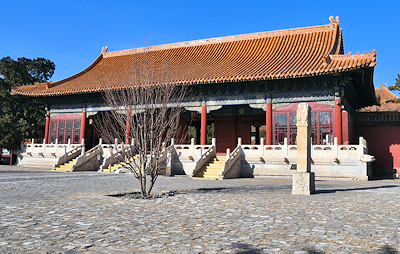
Eastern stele in front of Ling'enmen
This is the main entrance of the ceremonial area of the mausoleum. It is also nicknamed the "blessing and grace" gate carrying the meaning of showing veneration to the deceased and in return receiving thanksgiving and blessing from Heaven to the mere mortals.
The gate was built in 1427 and has two horse mounting steles in front. The doors and pillars are kept in bright vermilion lacquer and the other woodwork is painted in the traditional green and blue colors with some gold colored accentuation. A plague bearing its name is suspended inside the gate.
The gate is five rooms wide (about 31.44 meters) and two rooms deep (about 14.37 meters) and is surrounded by a white marble balustrade with three flights of stone. It is covered with a single-eaved gable roof covered by yellow glazed tiles.
Two steles facing each other stand a few meters in front of the gate, east and west, respectively.
Silk Burning Ovens
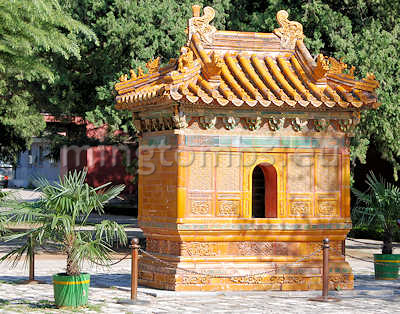
Silk burning oven
Inside the gate and on both sides of the central Sacred Way are the eastern and western sacrificial burners. These are small ovens decorated with green and yellow glazed tiles. They were used to burn silk and symbolic paper money - a custom that has survived almost unaltered at most Asian graveyards all the way till today.
These traditional silk burning ovens -Shenbo ovens- have been fully restored and stand glistening in the sun fully covered in yellow ceramic tiles. They are larger than those in other Ming mausoleums in Shisanling.
The single-eaved structure stands on a base with Buddha carvings.
Ling'en Hall - Hall of Eminent Favor
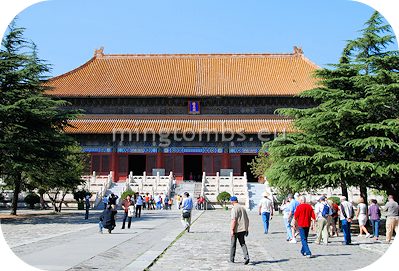
Ling'endian - Hall of Eminent Favor
Ling'en Hall is by far the most magnificent and impressive above-ground construction of all the Ming tombs. Also called the "Offerings Hall" memorial tablets with the names of the tomb occupants were kept here in the Ming dynasty. Sacrificial ceremonies were held inside the hall on the anniversaries of the deceased.
This large structure covers an area of 4,400 square meters. The main halls sits on a triple level balustrade of beautiful, white marble. Three flights of stone lead up to the plateau of the hall itself.
The lower Danbi stone has two horses between the mountain ranges. Horses were not commonly used in the later Ming Danbi stones.
The centre stairway is wider than the side ones and has in the middle of each level a Danbi stone block with engraved dragons and mountain tops.
The hall is a dazzling nine rooms wide and three rooms deep. One has to go to The Forbidden City to find larger Ming halls. The building is covered by a double-eaved hip and gable roof with yellow glazed tiles.

Nanmu wood columns inside Hall of Eminent Favor
The inside of the hall is exquisite and unique. The entire structure rests on 60 large columns of precious nanmu wood, each one made out of a single tree trunk and 12.6 meters high. The four innermost columns are up to 1.12 meters in diameter! The columns are left in their natural state and not covered with the traditional vermilion colored lacquer.
Also the beams and other interior woodwork are made of nanmu wood. This is in fact the largest extant Chinese historic building made with nanmu wood. The ceiling is gorgeously decorated with squares kept in rich green and golden colors.
In the center of the huge hall is an over-sized statue of Zhu Di -the Yongle Emperor- sitting on his imperial throne.
Gate to the Burial Area -Neihongmen
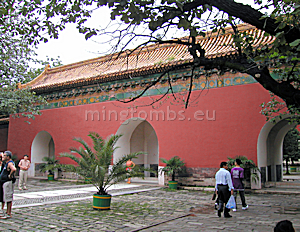
Neihongmen
In the later Ming dynasty and subsequent Qing dynasty this gate mostly became a triple gate on a raised platform, but in the early Ming dynasty when Changling was constructed this gate was a mere large and massive triple-opening entrance.
Having a depth of more than one "room" it is deeper compared to most other similar gates.
The building is covered by a single-eaved roof with yellow glazed tiles. A band of yellow and green colored tiles just below the roof construction adorn the building.

- Lingxingmen -
The Double Pillar Gate
Lingxing Gate and Sacrificial Vessels
Also known as the "Double Pillar Gate" this particular structure symbolizes the importance of the tomb occupant. It has a hipped roof carried by a intricate composition of a number of interlocking wooden pieces. It is erected across the central spirited Sacred Way of the mausoleum.
The idea of this structure stems all the way from the Western Han dynasty (206 BC - AD 25). Its purpose is to solicit blessing from the Lingxing Star for a good harvest.
But Lingxingmen served another higher purpose. It was believed that evil spirits were only able to travel in straight lines. By placing Lingxingmen across the all-important centre spirit axis of the mausoleum the evil spirits would be blocked and prevented from reaching the tomb mound and burial chamber.

Five sacrificial vessels
Each column is topped by a mythical Qilin. These beasts had many attributes, two of which were to punish the wicked and add protection. Their presence thus augments the effectiveness of the gate.
A little further north on the central Sacred Way is the stone altar with five sacrificial vessels made of stone.
The five pieces include an incense burner, a pair of flower vases and a pair of candlesticks. They were placed at this location as a token of sacrifice to the deceased.
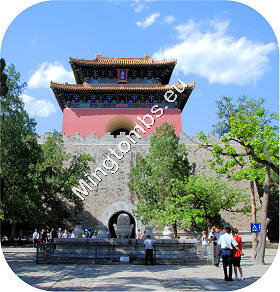
Square city and Minglou
The stone base is often richly decorated although in Changling the engravings are rather simple and nothing out of the ordinary, but good craftsmanship of the early Ming dynasty.
The Square City and Memorial Tower
The last structure in front of the tomb mound is the so-called "Square City". It is a large, tall stone covered platform on top of which sits a tower called Minglou -or "Memorial Tower".
The tower has an opening from all four sides although now the eastern and western accesses have been walled up. In the center of the building is a memorial stone tablet inscribed with "Tomb of Emperor Cheng Zu of the Great Ming". The characters are huge, each one some 33 centimeters square.

Memorial stone tablet
The characters read "Cheng Zu Wen Di Zhi Ling Mu". "Chengzu" is Zhu Di's temple name; his posthumous title was "Emperor Wen". Thus the inscription reads "Chengzu, Emperor Wen's tomb".
A hipped and gabled double-eaved roof with yellow glazed tiles cover the tower. Under the highest eave at the southern side is a plague inscribed with the name of the tomb -"Changling".
The Precious Mound
Emperor Zhu Di and Empress Xu are actually entombed some 10-15 meters below the large, almost circular earth mound at the northern end of the mausoleum.
Presumably, the underground tomb chamber remains intact despite the heavy pile of earth that has been weighing down upon it for almost 600 years. If it had collapsed then this would have been clearly visible and given away the exact location of the underground chamber.
The mound is encircled by a wall, which has a stone covered perimeter walkway with buttresses. The wall protects the burial chamber but also keeps the large amount of soil in place. Eastern and western flights of stairs lead from the ground level up to the memorial tower. These walkways are connected to the perimeter walkway of the mound.
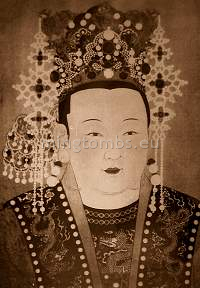
Empress Xu
The Empress Xu and her Sister
Empress Xu, formally Empress Renxiaowen, and with birth name of Xu Yihua, was the daughter of Lady Xie and Xu Da, duke of the state of Wei and one of the cofounders of the Ming Dynasty.
At the age of 14 in 1376 she was bestowed the title of Princess of Yan as her husband at that time was Prince of Yan. Two years later she gave birth to Zhu Gaozhi, the later Hongxi Emperor.
She became empress, when her husband usurped the throne in December of 1402, but she passed away already five years later in July of 1407. Upon her death the Emperor bestowed her title of "Empress Humane and Filial".
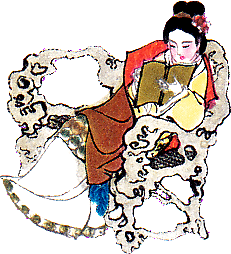
"Girl Student"
When her son ascended the throne in 1424 as the Hongxi Emperor he bestowed her additional titles of "Compassionate and Virtuous", "Sincere and Bright", "Sedate and Devoted" and "Match for Heaven and Equal to the Sages".
All the way from childhood she had been a quiet girl, who was fond of reading. Her nickname in the family was the "Girl Student". Thus, being both learned and educated Xu Yihua took active part in court politics.
As Empress she once summoned the wives of all the senior court administrators to her premises and gifted them with clothing and money. She next instructed them to prevail upon their husbands to always bear the well being of the people in mind in all their doings and not to be arrogant towards their subjects or their families.
She authored and published several books, one of which was "Household Instructions" covering 20 chapters. Her books were distributed all over the empire.
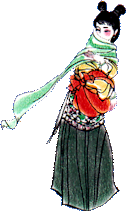
In January 1413 her coffin was moved from Nanjing to Beijing under escort of Prince of Han, Zhu Gaoxun. She was interred the following month upon the completion of Changling.
When Empress Xu died, the Yongle emperor chose as his second bride her younger sister, Xu Miaojin. She would however have nothing of it, shaved her head and became a Buddhist monk. Zhu Di never remarried.
Immolation
In line with customs at the time, the deceased emperor's concubines were either killed or made to commit suicide and buried with him. Some were outright buried alive near the mausoleum. The purpose was to follow the emperor into the netherworld and service him there in all perpetuity.
In the case of the Yongle emperor, 16 persons were buried alive in the eastern and western "wells" on either side of the Chang Ling. There is no trace today of these burial sites.